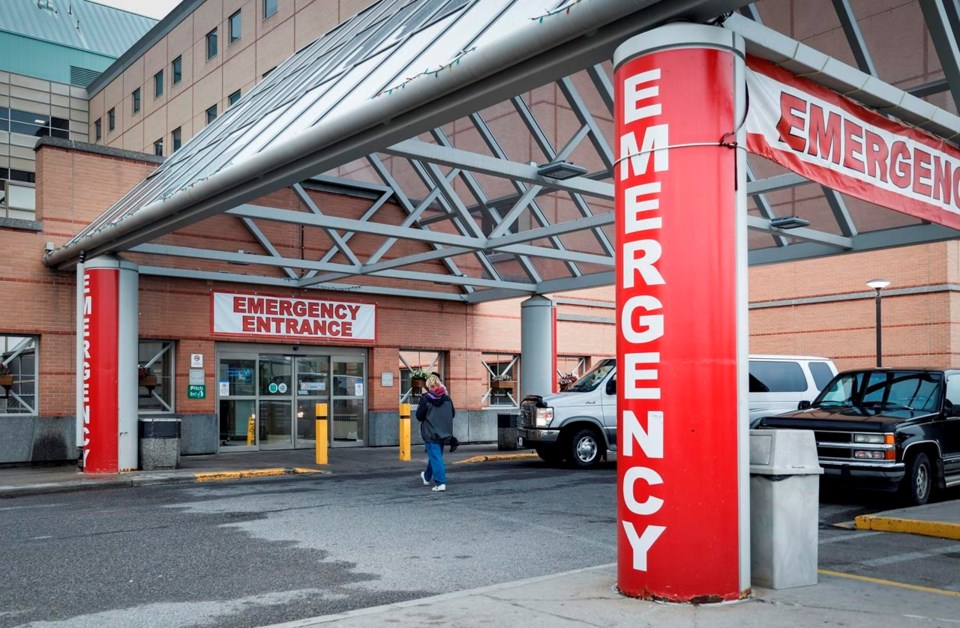VANCOUVER — The head of a national group of emergency room doctors says he's "disgusted" that provinces and territories have generally not planned for expected overcrowding in ERs, especially as respiratory season starts to peak in many areas.
Dr. Michael Howlett, president of the Canadian Association of Emergency Physicians, said that governments and hospital administrators have failed to heed the warnings of health professionals taxed with caring for more patients, including those who often end up in hallways instead of wards where they would get better care.
"I am frustrated that there are people in control of the system that think they know better than many of us with lots of experience on the front lines dealing with patients," said Howlett, who works in rural and urban ERs for Lakeridge Health based in Oshawa, Ont. He was also chief of emergency medicine there until last September.
"Many emergency physicians who have tremendous administrative and leadership expertise across the country, many are in leadership roles and in many instances have a lot to offer. And no one wants to pay attention. Everyone else thinks they know our specialty, and they don't."
Howlett made the comments Wednesday as British Columbia's health minister said 10,435 patients — a record number — were in hospital Tuesday night, many of them with a respiratory illness.
"It's very challenging," said Adrian Dix, adding that 18,000 health-care workers recently missed at least one day of work due to illness, putting additional pressure on the system.
Dix said it's a "particularly challenging time" for the health-care system but that the province had administered 1.5 million doses of a flu vaccine, the highest number in Canada.
Emergency rooms elsewhere in the country were also over capacity as rates of influenza and respiratory syncytial virus, or RSV, which can be serious for infants and older adults, have climbed steadily.
In Quebec, ERs were at 137 per cent capacity on average, with Health Minister Christian Dubé saying about 1,900 people a day were visiting ERs, double the number compared to last year.
Dubé said almost half of the daily ER visits are for non-urgent ailments that could be treated at a primary care clinic or doctor's office but that it may be tough to get an appointment.
"The system needs to do a better service for those (minor cases)," added Dr. Gilbert Boucher, president of the Association des spécialistes en médecine d’urgence du Québec and an emergency physician at the Montreal Heart Institute.
Bonnie Henry, the provincial health officer in British Columbia, said respiratory season was expected to hit its peak next week as more people likely become infected with the H1N1 flu virus.
"That's really one of the things that's causing the most illness route now," she told a joint news conference with Dix.
"H1N1 does tend to affect younger people more and can still cause a very severe illness and can cause people to be more susceptible to having a bacterial infection after having influenza infection," Henry said.
Three children have died of flu-related deaths in British Columbia, and they all had secondary bacterial infections, Henry said.
"It is so sad and tragic when we know that young people can be protected from these infections. But we know that any respiratory virus can cause an inflammation in the lungs that makes you more susceptible to having bacterial infections."
Unlike viruses, bacterial infections can be treated with antibiotics, Henry noted.
Most children do not need to be hospitalized when treated in an ER, Henry said.
"But (influenza) continues to cause pressures on emergency departments and we encourage people to make sure that they take their child in if they have concerns at all. We also have seen that the emergency department visits have increased, particularly over the last six weeks, and the proportion of visits for acute respiratory infection have increased, particularly in children zero to 14 years of age."
Henry said 24 influenza outbreaks have occurred in long-term care homes over the last eight weeks, with nearly half of those in the last week of December, making some people severely ill.
Howlett said a surge in ER patients often means patients have to be put in uncomfortable stretchers in hallways, which increases the risk of developing bed ulcers, especially for elderly people who can't sleep in noisy, bright areas with lots of people walking by.
"There are a number of factors in emergency departments that contribute to it being not a stable area for people who are admitted."
Howlett's group met with provincial and territorial health minsters during their gathering in Charlottetown, P.E.I. last October to discuss how they could all join forces at a national forum this spring to come up with potential fixes to overcrowding in emergency rooms.
So far, no jurisdiction has responded to the invitation, said Howlett, adding the doctors expect to go a head with a gathering anyway.
— With files from Sidhartha Banerjee in Montreal
This report by The Canadian Press was first published Jan. 10, 2024.
Canadian Press health coverage receives support through a partnership with the Canadian Medical Association. CP is solely responsible for this content.
Camille Bains, The Canadian Press



